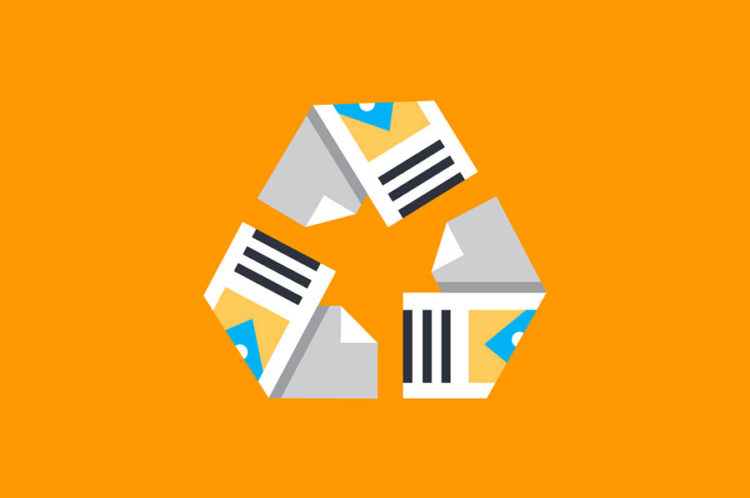This article discusses the benefits and best practices of repurposing old content. It provides an overview of different ways to repurpose old content, including turning blog posts into videos, transforming blog posts into infographics, turning webinars into blog posts, and creating social media posts from blog posts.
As content creators, we’re always looking for ways to reach new audiences, engage our existing audience, and get more value from our content.
One way to achieve these goals is by repurposing old content. Repurposing old content involves taking existing content and presenting it in a different format or platform. In this article, we’ll explore the benefits of repurposing old content and provide tips and strategies for doing it effectively.
Benefits of repurposing old content:

source: Google Images
Repurposing old content has several advantages, including:
- Saving time and resources: Repurposing old content allows you to reuse existing material, saving time and effort.
- Increasing reach: Repurposing content in different formats and platforms can help you reach new audiences and expand your reach.
- Improving engagement: By repurposing old content, you can update it with new information, make it more visually appealing, and tailor it to specific audiences, which can improve engagement and drive more traffic to your website.
- Maximizing ROI: Repurposing old content can help you get more value from your existing content and increase your content marketing ROI.
Ways to repurpose old content:
Turn blog posts into videos:
Creating short, engaging videos from blog posts is a great way to repurpose content. Videos can be shared on social media platforms and video hosting sites like YouTube and Vimeo.
Videos allow you to engage with your audience in a different way than written content and can help you reach a wider audience.
Transform blog posts into infographics:
Infographics are a great way to present data and statistics in a visually appealing way. Transforming blog posts into infographics is a great way to repurpose content and engage with your audience. Infographics can be shared on social media platforms and other sites.
Turn webinars into blog posts:
Repurposing webinars into blog posts is an effective way to reach a wider audience. By summarizing key points and takeaways, you can create valuable content that resonates with your audience.
Create social media posts from blog posts:
Using quotes, statistics, and other snippets from blog posts to create social media posts is a great way to repurpose content.
Social media posts allow you to engage with your audience in a different way than written content and can help you reach a wider audience.
Update old content:
Updating old blog posts with new information, statistics, and visuals is a great way to make the content more relevant and engaging. By updating old content, you can provide more value to your audience and improve your content marketing ROI.
Create eBooks from blog posts:
Compiling blog posts into an eBook is a great way to repurpose content and provide value to your audience. eBooks can be downloaded and shared, and they allow you to reach a wider audience.
Republish old content on new platforms:
Republishing old blog posts on new platforms like LinkedIn, Medium, and Quora is a great way to reach new audiences. By republishing old content on new platforms, you can provide more value to your audience and improve your content marketing ROI.
Best practices for repurposing old content:

source: Google Images
- Know your audience: Before repurposing old content, it’s important to understand your audience and what they want. By knowing your audience, you can tailor your content to meet their needs and preferences.
- Maintain quality: When repurposing old content, it’s important to ensure that the quality of the content remains high. This means updating old information, adding new visuals and graphics, and ensuring that the content is accurate and up-to-date. By maintaining quality, you can provide value to your audience and improve engagement.
- Use different formats and platforms: To maximize the impact of repurposed content, it’s important to use different formats and platforms. This means creating videos, infographics, social media posts, eBooks, and more. By using different formats and platforms, you can reach a wider audience and engage with your audience in different ways.
- Promote repurposed content: Promoting repurposed content is just as important as creating it. This means sharing repurposed content on social media, email marketing, and other channels. By promoting repurposed content, you can increase engagement, drive traffic to your website, and improve your content marketing ROI.
- Measure results: Finally, it’s important to measure the results of repurposed content. This means tracking engagement, traffic, and other metrics to see how repurposed content is performing. By measuring results, you can identify what’s working and what’s not, and make adjustments to your content marketing strategy accordingly.
Conclusion
Repurposing old content is an effective way to get more value from your existing content and engage with your audience in new and exciting ways.
By using different formats and platforms, maintaining quality, and promoting repurposed content, you can reach new audiences, improve engagement, and drive more traffic to your website.
Remember to measure results and make adjustments to your strategy as needed. With the right approach, repurposing old content can be a powerful tool in your content marketing arsenal.

